by Emily Li
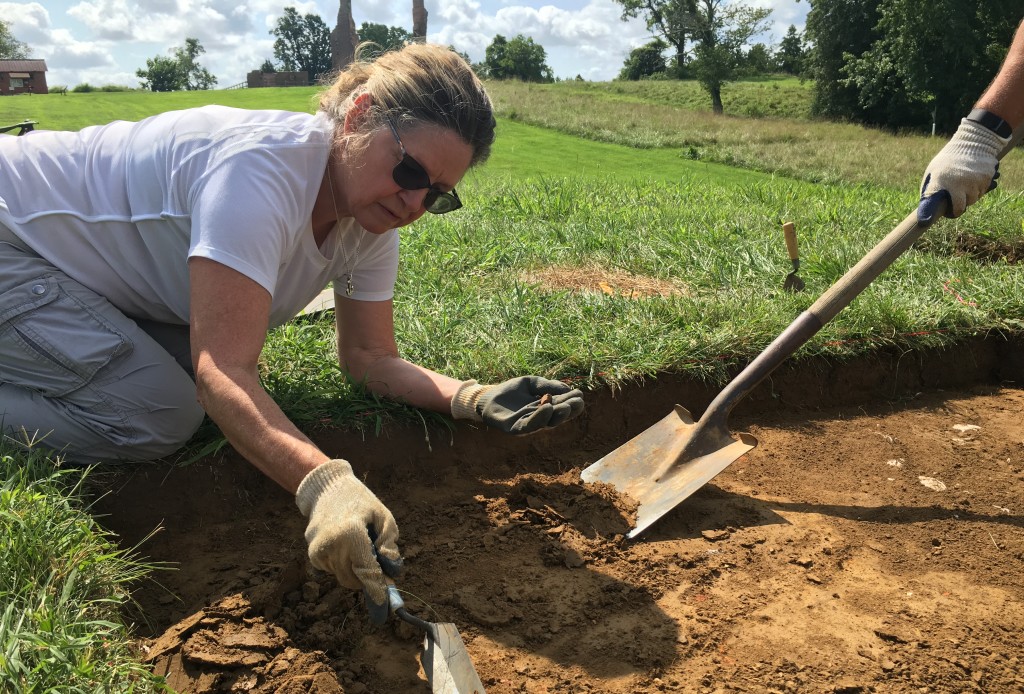
Citizen scientist Linda Perkins helps excavate a soil plot in front of the Contee mansion ruins. (Photo: SERC)
People don’t usually think of archaeologists as dumpster divers. Then again, sifting through trash for hidden treasures is exactly what the volunteer citizen scientists of the Smithsonian Environmental Research Center (SERC) Archaeology Lab do every Wednesday. But they don’t scavenge anything for themselves. (The market for millenia-old oyster shells is very unpredictable, and any food they find is always up to three centuries past its expiration date.) Instead, they take away new skills and a chance to put together a historical puzzle larger than themselves.
“We look back thousands of years,” said Jim Gibb, the lead volunteer and coordinator of the lab. “I always tell people—we’re the time lords.”
Reading the bones
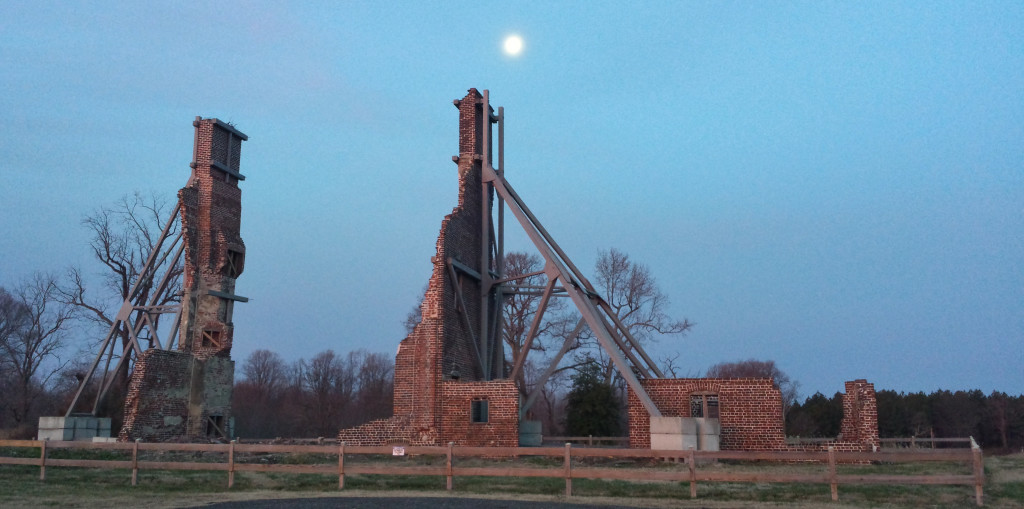
Ruins of the Contee Mansion, built around 1750. Before its construction, English emigrant Thomas Sparrow and his family lived here. (Photo: SERC)
In 1649, a man named Thomas Sparrow and his family moved to Maryland. Originally English emigrants to Virginia, they were escaping growing tension between Anglicans and Puritans in the mid-17th century. When Maryland passed the 1649 Act of Toleration allowing freedom of worship to Puritans, Sparrow took his wife, two young children and a servant to “Sparrow’s Nest,” a 590-acre parcel of land on the Rhode River that had belonged to his father and now sits on the SERC campus.
The Sparrows lived there for almost a century. In 1705, one of their descendants–Thomas Sparrow’s grandson—stole a boat and became a pirate in the Carolinas. (Unfortunately, there’s no evidence he was related to Captain Jack Sparrow.) Their neighbors, the Shaws, arrived shortly after the first Thomas Sparrow, christening their land “Shaw’s Folly.” But by the mid-1700s, both families had moved on. The Sellman family took over Shaw’s Folly in 1729, and the Sparrows sold their land to Annapolis merchant Nicholas Maccubin in 1747. Maccubin then built a mansion whose brick chimneys still stand at SERC today.
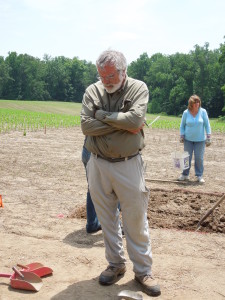
Jim Gibb, head of SERCs volunteer archaeology lab, inspects a soil excavation. (Photo: SERC)
The site’s rich past is reflected in the historical trash deposits SERC’s citizen science volunteers are sorting through. They’ve discovered oyster shells, foot-long keys, pieces of ceramic and glass, pipes, bone fragments, preserved fish scales, and handcrafted nails. Together, these individual pieces paint a much larger picture of the relationship between people and their environment. For example, analyzing and identifying bone fragments tells the story of what these families had for dinner on an average Tuesday night in the 17th century.
“You’d think they’d be hunting deer, but in the thousands of bone samples we have identified, we have three deer fragments,” said Gibb. “These people were not eating deer.”
Gibb believes only the first two generations of Shaws and Sparrows hunted deer, which was usually reserved for aristocrats in the Old World. By the time the third generation cooked dinner, they were sick of venison and had reverted to two English favorites: beef and pork. But according to the bones in their separate trash middens, the two families didn’t prefer them equally. “We have the Sparrow family seemingly having a preference for beef, and the Shaw family seeming to have a preference for pork,” Gibb explained.
This difference is about more than taste—it also indicates how the families used their land. Eating more beef, today or centuries ago, causes greater ecological damage than eating pork. Pound for pound (and stomach for stomach), cows eat far more than pigs do, which means more land, more plowing and tilling, and more manure.
“Two different animals, two different effects on the environment, two different lines of husbandry practices,” Gibb said. “This is something we’re exploring in great detail now.”
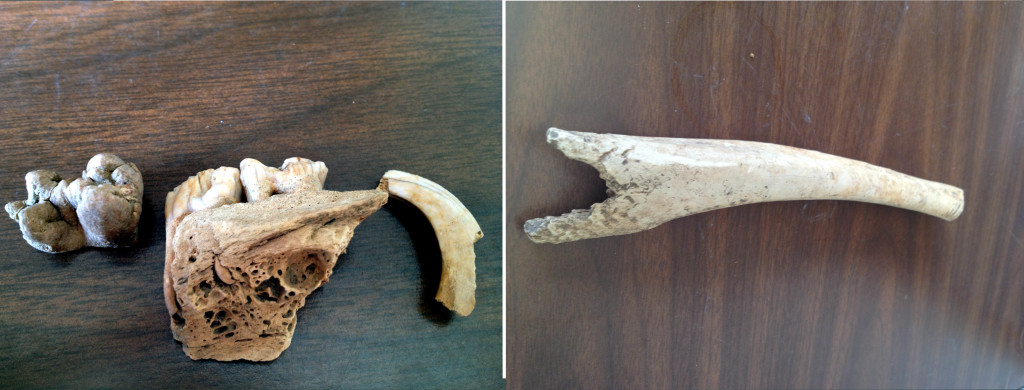
Pig teeth (left) and a deer leg bone (right). The bones unearthed by the lab indicate these 17th- and 18th-century families ate far more pork and beef than deer. (Photo: SERC)
Researching from the ground up
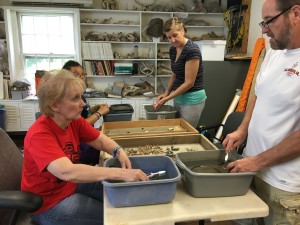
Janet Herron (left) and Leo Plourde (right) wash artifacts from the lab’s excavations. (Photo: SERC)
On a blistering Wednesday afternoon, a team of volunteers piles into the Sellman House, now the headquarters of the Archaeology Lab. A skull sits in the trashcan. Shelves of artifacts tower from floor to ceiling, femur bones and ceramic shards glowing faintly in the overhead light. High schoolers gather in the back room by the coffee, while the retired people gather around sifters beside buckets of oysters waiting to be brushed and cleaned. As they pick through the sediment, they have plenty of time to discuss discoveries—and stretch their imaginations.
“We make up stories about the artifacts we find,” said citizen scientist Leo Plourde. “Maybe one household was stealing silverware from another. Maybe someone’s wife was having an affair.”
But the citizen scientists aren’t just asking questions. They’re answering them with independent research, whether dating clay pipes, studying eroded topsoil flow, or analyzing pollen cores. Plourde, who’s been with the lab for a year and a half, is working with another citizen scientist to measure and statistically analyze oyster shells. They hope the information will shed light on how oysters were being gathered historically and how abundant they were millenia ago, which could feed into a conversation on seafood management and conservation today. According to Plourde, some of the shells date as far back as the Early Woodland period (1000-200 BCE).
The volunteers come from all walks of life, from high school and masters programs to the National Security Administration. Janet Herron, a U.S. Government Publishing Office retiree, said her experience in archaeology has been both exciting and calming.
“I like sorting through the soil to see what you come up with, whether you find a nail, or pottery, or buttons,” said Herron as she rolled what looked like a large grain of sand between her fingers. “I like the discovery part of it, when you get back and shine it all up.”
“There’s always an element of surprise … It’s what makes it fun,” said Kathleen Clifford, a volunteer with a masters in classical archaeology, who has been with the lab nearly since its inception. “The difficulties you come across in your research questions are just opportunities to direct and adjust.”
Perhaps it’s easy to be optimistic in an environment like the Archaeology Lab, where there are just as much data as there are questions—and enthusiasm. Just then, Herron tapped on my shoulder, carefully dropping the grain of sand into my palm.
“Look,” she said excitedly. “It’s a vertebra. I wonder from what?”

